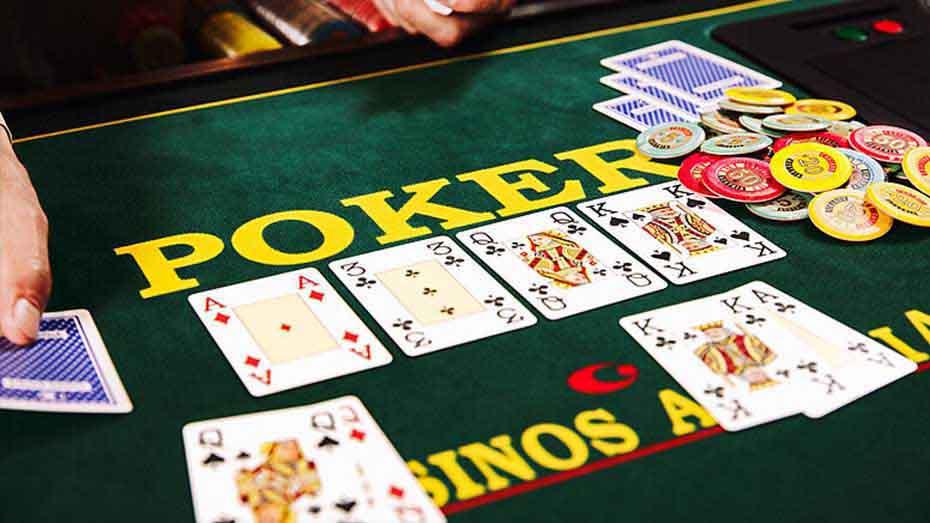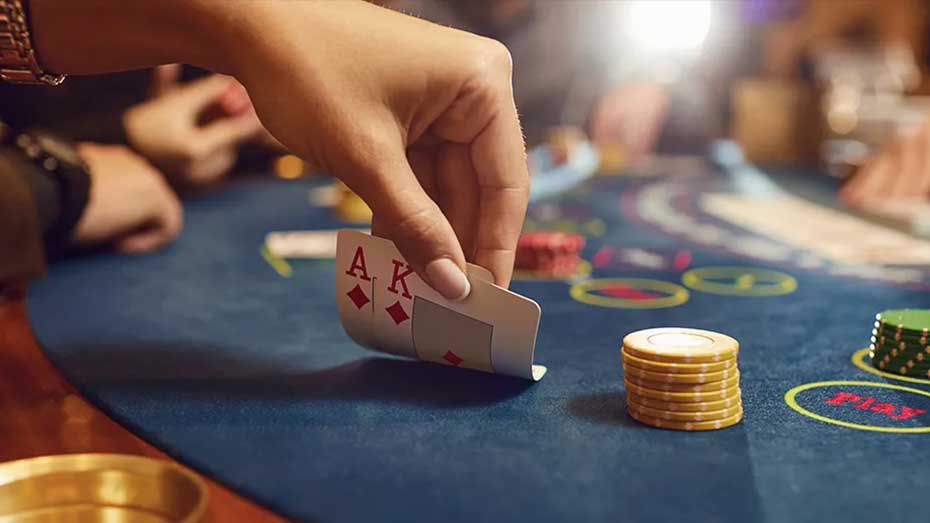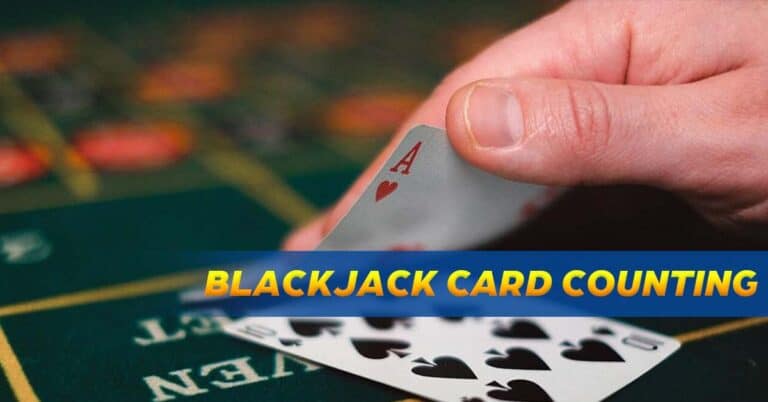How to Play Poker: Poker Rules Made Easy with This Guide
Trying to figure out how to play poker? Don’t worry. We’ll show you how to play this clever card game in easy steps. You can find a lot of information and tips about how to play this classic game at online casinos. You just need to learn the rules, and then you may begin to come up with your unique winning strategy!

1. Learn Basic Card Hands Ranking
No matter what kind of poker you play, the cards will always be the same. Print out a “cheat sheet” and study it to start learning about the different hands. Then, remember each hand so you can easily tell them apart. From best to worst, here are the winning poker hands:
The best hand is a royal flush, which is also called a royal straight flush. This hand has an Ace, King, Jack, Queen, and 10 of the same suit (all clubs, diamonds, hearts, or spades). A royal flush of another suit can only tie it, but it can’t beat it.

Five cards in a row of the same suit make up a straight flush.
Four of a kind indicates that you’ve got four hand cards of the same ranking (but similar suits) and a fifth card of any rank (like four aces and a 9). If you have four aces, no one else can have a hand that includes an ace, so there is no royal flush.
A full house is made up of three cards of the same rank and two cards of the same rank of a different rank.
Five cards of the same type make up a flush. They don’t go in order, but they are all from the same suit.
A straight one is made up of five cards that are all the same number but from different suits.
When you have three of a kind, you have three cards of the same number plus two cards that don’t match.
Two pairs are made up of two cards of the same rank, two cards of a different rank (not the same rank as the first pair), and one card that doesn’t have a match.
When you have a pair, you have two cards of the same number and three other cards that don’t match.
The hand with the high card is the worst, or “nothing” hand. When no two cards have the same rank, they are not in order, and they are not all the same suit.
Note: If two people have the same kind of hand, the one with the higher-ranking cards wins. If both hands have the same card ranks, regardless of suit, it’s a tie, and if there’s a prize, it’s split equally.
2. Crafting your Strategy
Reading Your Opponents: Observing opponents’ behavior and betting patterns can provide valuable insights into their hands. Look for consistent tendencies to help you make informed decisions.

Calculating Pot Odds: Pot odds help you determine whether a call or fold is mathematically justified. This skill is essential for making profitable decisions.
The Importance of Position: Your seating arrangement relative to the dealer button affects your decision-making. Being in a later position allows you to gather more information before acting.
3. Place Bet
Put up the blinds, which are the starting bets, or “ante up.” At the start of a game of poker, bets can be made in one of two ways. In Texas Hold ’em, the player to the left of the dealer usually makes a big blind wager that is at least the minimum bet, while the player to the right of the dealer usually makes a small blind bet that is half the minimum bet. Each player can also “ante up” the required starting wager, which means to put in the amount of the minimum starting bet.

Except for Texas Hold ’em, most types of poker use the “ante up” method.
4. Look at Your 2 Card
Take a look at the two cards the dealer gives you to figure out what your hand is. The dealer will burn the one and first card, which means to take it out of the game. Then, they’ll give each person two cards. Look at your cards to find out what you have.

In poker, every time the dealer deals, he or she will burn a card. This makes it harder for players to guess what card will come up next, making the game more of a risk.
The dealer will always start on the left and pass out the cards in a clockwise direction.
5. Bet, Call, or Raise
Following the dealing of each round, you may choose to bet, call, or raise. You will place a wager each time the dealer deals out a fresh hand of cards, with the initial wager being made simply on the basis of the two cards each player is holding. When it’s your turn to bet, you have a few alternatives. Betting happens in a circle. Right now, you can:

Declare “raise” to add more funds to the betting pool. In the event that you “raise,” the other players will travel around in a circle and decide whether to “call” your increased wager or “fold.”
If another player has a bet and you don’t want to match it, say “fold.” If you decide to fold, deal your cards face-down to the dealer to prevent the other players from getting an advantage.
6. Examine Flop on How to Play Poker
To determine whether you have a strong hand, look at the “flop.” The dealer will “burn” the highest card of the deck following the opening round of betting. After that, they will deal with the “flop,” which is when three cards are dealt face-up on the table. These are the shared cards that can be used by all players to assemble their hands. After comparing these cards with the ones you have in your hand, decide whether to wager, call, or fold.

The dealer will display a total of five cards. Your two personal cards in your hands and the five communal cards on the table give you a total of seven cards to use to make your best hand of five. Even though your luck may change later in a game, take some time to assess the table after the “flop” to see if you’re in a good position to win the round with a strong hand.
You may also draw new cards to replace the cards in your hand, depending on the game’s variation rules. It is generally done during or immediately following the betting round.
7. Check the “Turn” Card
The “turn” card or the “fourth street” card is what it is known as. To decide whether to bet, call, or raise, check all the cards on the table and the cards in your hand.
At this stage, your game might also permit a card trade, but this is uncommon in competitive games.

Consider the potential hands that the other players could have as you examine the cards. For instance, if there are four spades on the table, every player holding a spade will have a flush, which is defined as having five cards from the same house.
Similarly, anyone holding a four or a nine will have a straight if the cards on the table are 5, 6, 7, and 8.
You might want to fold if you don’t have anything valuable in your hand, but the cards on the board make for an obvious winning hand, as it’s likely that another player does.
8. Limit vs. No Limit on How to Play Poker

No Limit
The phrase “no limit” seems easy to understand. Any time during a no-limit poker game, a bettor can wager all of his or her chips.
Most no-limit games use blinds and a button. See Blinds, Ante, and the Button to learn more about this method.
For instance, let’s say we’re watching a $1/$2 no-limit hold ’em cash game. In this example game, there are six people sitting around the table, and each has 200 chips.
The small blind puts up 1, and the big blind puts up 2. After the cards are given, the person to the left of the big blind starts the first round of playing before the flop. The small blind, or the first player to the left of the small blind, bets first in every round after the first.
In a no-limit game, this person can bet any amount, up to all of his or her chips. Going all-in means that this player puts all 200 chips on the table.
Any player can go all-in at any time during a hand. Keep in mind that the highest amount for an “all-in” is the same as how many chips a player has in front of them when the hand begins.
Limit
Almost all versions of stud poker, which is a type of poker, have limited playing rules. But any poker game can be played with a small number of bets.
A Stop When a Texas Hold ’em game has limits of $2/$4, the blinds are usually $1/$2. In limit games, there is a “small bet” and a “big bet,” and the “big blind” is usually the same size as the “small bet.”
In many limit games, the highest bet or raise starts out at the same amount as the small bet and goes up to the amount of the big bet as the game goes on. After three raises, the betting is “capped” in each round, and the next player can only call.
9. Decide on your hand
Check the “river” card and choose which hand you want to play. After the dealer “burns” the top card of the deck, they will put one more card face up next to the “turn” card. The name for this last card is “river.” Check the cards you have and the cards in the community to figure out what the best 5-card hand is. Then, you can bet, call, or quit.

If the rules allow it, you may be able to change your hand one last time before or after betting. But this doesn’t happen often in professional games.
FAQs
Conclusion
It is time to start looking for the best websites to practice poker online now that you are familiar with the fundamental poker rules and have our links to return to your poker guidelines whenever you find it necessary to do so. Hold off on playing poker for real money until you’ve had some practice first. You can play the games for free to get a feel for them. That is the only way to find out for sure if you have truly mastered the skills necessary to play poker.


















